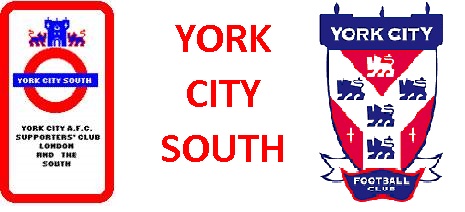

Bootham Crescent - Memories
Bootham Crescent holds many memories for many people. Here are just a few. Please email your Bootham Crescent memories to us for inclusion
The Good Old Days
Reaching 100 Points
Keith Walwyn
The Old Shippo
Big Wins
Butch Wilkins
Quirks Of BC
KC - Sheffield
Steve Claridge
1974-76
Seat Creep
28,123 – Record Attendance
Bobby Robson
The Tunnel
Nobby Stiles - A Unique Bit Of Skill
The Last Non Floodlight Games
Floodlights Come To Bootham Crescent
1983/4 – Best Ever Season?
Blanket Collections
Bootham Crescent - Other Uses
Cup Glory / Gory
Nobby Clarke
Hyla Campbell
Alf Patrick
1970s: What Might Have Been
Quirks Of BC
Some Personal Recollections
Adrian Durham
To mark City’s departure from Bootham Crescent, talkSPORT presenter Adrian Durham penned “A Love Poem to Bootham Crescent”. He cut his broadcasting teeth in York on Viking Radio between 1989 and 1991. John Murray, a well known figure at 5Live was a broadcasting contemporary at the ground.
Dave Bower
"Farewell To Bootham Crescent", by Jiggerypoetry, commissioned by Radio York
Bye Bye Bootham
Farewell
Away Games
Turn up, win, go home.
Happy days.
Power personified, he never gave less than 100% and often it was much more.
Ungainly yes, when I saw him make his debut, I couldn't believe how clumsy he was and came away convinced Eddie Flood, the other debutant, was our best left back since Phil Burrows.
First impressions were wrong. Keith regularly terrorised defences, no more so than a rain sodden pitch when he absolutely pulverised Gillingham during a 7-1 win.
One regret? He never had the opportunity to play at a higher level and show he could mix with the best.
No roof, grassy banks at the top and a scoreboard which provided some protection from the rain for a few in the pre Longhurst Stand days.
I’m far too young to remember when City beat Southport 9-1 in 1957 to record our biggest win to date.
I do remember a number of 7 goal wins in the 1980s. My highlight being a 7-1 win over Gillingham in 1984. Torrential rain meant the pitch was a bog, somehow, Keith Walwyn kept his feet throughout, he terrorised the Gills and was instrumental in Keith Houchen's hat trick. I recall big Keith mesmerising the Aldershot defence, particularly their keeper Glen Johnson, around that time on 3 consecutive seasons leading to 3 big wins.
Somehow I missed a Tommy Canham hat trick when we beat Darlington in 1985.
More recently we beat an abject, cash strapped Kettering 7-0 in The Conference.
Roll on some more big wins.
1976, City are struggling badly in Division 2 and Chelsea are the visitors. In the midst of a financial crisis, they’d introduced many young players into their side named 18 year old Ray “Butch” Wilkins as their captain. One moment sticks in my mind. Butch as he was commonly known in those days showed composure beyond his years as he picked up the ball on his own goal line inside the 6 yard box and dribbled along the goal line for about 10 yards, turned infield and dribbled out of the penalty area, he looked up and played an inch perfect pass to a teammate on the half way line. Pure class.
2 other pieces of skill stick in my mind.
1985 and Liverpool take the lead in our FA Cup tie. Liverpool had what looked like an innocuous free kick inside the centre circle. The ball is played to Ian Rush. With his back to goal, he collects the ball around the “D”, cushions it, spins and shoots 1-0. From behind the goal, it looked spectacular, the ball was in the net in an instant and showed the gulf in class between the 2 sides.
Number 3 on the list is Gary Howlett. A nondescript league game with City struggling. A City attack broke down, he ran back, tackled an opponent from behind and won the ball cleanly on the half way line. He went forward with the ball, playing the ball with outside of his foot, it swerved around the defence, inch perfect for Phil Wilson whose shot hit the side netting. Later, when I spoke to Howlett, he said he didn’t tackle very much but recalled how Dave Sexton, when they were both at Coventry, had always encouraged him he to tackle more often.
Its strange to recall how Bootham Crescent came about. Spring 1932 and the directors felt our Fulfordgate ground wasn’t up to scratch, being distant from the city centre with very poor tranport links (a single tram line and no buses), in need of substantial renovation and just a small catchment area. After a lengthy debate, the directors agreed to move to Bootham Crescent, the main stumbling blocks being moving to a rented ground (we didn’t buy the freehold until 1948) and poor drainage at Bootham Crescent.
It took just 4 months to build the new ground and we opened with a 2-2 draw with Stockport.
Fast forward 72, 73, 74 .... 86, 87, 88 years and we’re on the move again. Our home is once again in need of renovation and is considered not fit for purpose in the 21st century. We’re moving from our own ground to a rented stadium. The city centre location that was appealing is now considered a handicap.
Roll on the days when we can celebrate promotion and cheer on wins over the likes of Arsenal at our new ground.
Didn’t like it when it was called Kit Kat Crescent, but many happy memories of seeing my beloved Sheffield Wednesday play (and win) there and the some great days out in York. 1975 was a low point, but hope to see us playing you in the league again.
As a young lad playing for Portsmouth, I was about to take a corner when someone in the crowd reached over punched me.
Having been brought up on lower league football, 1974 saw City promoted to Division 2 (now The Championship) for the first time in our history. The ground was spruced up, seats in the Pop Stand, Y fronts and a go ahead image to welcome the big boys.
That season, Aston Villa, Sunderland and Manchester United were teams we played in the league for the first time ever. We welcomed our World Cup winning captain, Bobby Moore and did the double over his Fulham side. In the FA Cup, we welcomed Arsenal in 1975.
The following season, we bowed out of the cups with home defeats to Liverpool and Chelsea and ended our stay in Division 2 with a home league defeat to Chelsea. The first season, we held our own but in year 2, our age old problem of not being able to refresh a side that was breaking up saw us relegated.
Bootham Crescent has changed a lot over the years. About the only thing not to have changed is the relentless seat creep.
When the ground opened in 1932 (built in just 4 months), the ground had about 800 seats.
When we set our ground capacity record attendance of 28,123 in 1938, that meant, less than 3% were seated, fans spilled over the barriers and stood on the old cinder perimeter track.
In 1955, we had 21,000 inside Bootham Crescent for our FA run, barely 1,000 (5%) were seated. Later that year, the final quarter of the Main Stand was built using finances from the cup run. Look carefully and you’ll still see the join in the brick work.
The next seat creep occurred in 1974 when seats, bought second hand from Manchester City, were installed in The Popular Stand, more than doubling the number of seats in the ground.
Subsequently, the seats at the Longhurst end of The Pop were removed to provide covered standing accommodation but were eventually re-instated.
Nearly every ground development has seen an increase in seated capacity. The only major ground development that didn’t add seats was the Roof Appeal for David Longhurst Stand.
The Enclosure finally disappeared in 1994 (in 2 stages) as The Main Stand was extended down to touchline.
Later, health and safety regulations (meaning each person must have more space) and weak foundations which resulted in the Grosvenor Road terrace end gradually decrease in size as sections are deemed unsafe, have seen Bootham Crescent reduced to today’s capacity.
Today, around we have about 3,400 (40%) seats in an 8,000 capacity ground.
2018/9, with a much reduced capacity from its heyday, about 40% of the capacity is seated.
Monks Cross: 100% seated.
It is hard to imagine 28,123 fans packed into Bootham Crescent, but that’s what happened in March 1938 when gripped by FA Cup fever, City reached the quarter finals for the first time and hosted local rivals Huddersfield,. Then a top team, they’d been England's league champions for 3 consecutive seasons in the 1920s.
If you look on YCS TV you will find film from the game. It was pay on the day and crowds poured in, spilling over the barriers and massing on the cinder perimeter track. The fans saw an action packed game but no goals. City lost the replay but that run capped earlier cup runs and really put City’s name on the football map.
The gate receipts? Just £2,735, making the average admission price just 10p, well worth it.
1989 and Bobby Robson takes his England squad to play a warm up game at Aylesbury. Fast forward to 1990. Italia 90 is approaching and The Shipton Street Roof Appeal is in full swing.
Unbeknown to the club, we write a letter to Bobby Robson and The FA asking if they’d send the England team to Bootham Crescent to play a fund raising game as part of the team's prep for Italia 90.
Club Secretary, Keith Usher’s high regard for Bobby Robson is well known to the City's youth team coaches, the likes of Gary Naylor and Colin Sanderson, who regularly play a trick on Usher. From outside, they ring Keith and pretend to be Robson. Keith plays along and then tells them where to go until they tire of the joke.
One day in spring 1990, the phone rings, “Hi, its Bobby Robson”, Keith plays along; the caller insists he really is Bobby Robson. Keith continues effing and blinding down the phone in true Keith fashion.
“But it is really Bobby Robson, I’m afraid we can’t bring the England squad to York for the friendly”.
Finally, Keith realises it really is Bobby Robson on the phone and apologises. Its the first ever time he’s spoken to his boy hood hero. He’s told him where to go in no uncertain fashion. Ever the gent, Bobby Robson takes it all in good humour and once again apologises for being unable to help the appeal. A true gent.
Probably the most iconic part of our ground is the tunnel.
It runs the length of The Popular Stand. Originally built to provide a means of exit after the game, it also allowed fans from behind both goals to transfer to the other end, depending on the way City (and our opponents) were kicking.
Traditionally, The Grosvenor Road end was the home end where most City supporters congregated. Come the pre match toss, if we were defending that end, we’d see a mass exodus via the tunnel to the other end. Equally at half time, the tunnel got busy again.
The tunnel was closed in the very early 1970s, putting an end to always being behind the goal City were attacking.
At the time, the enclosure provided an alternative means of transfer. A wooden gate being opened to cross the path the players took from the dressing room to the pitch. Time makes my memory a little hazy, but I seem to recall doing that route as well, and not having to pay any extra to go into the enclosure.
Come 1974 and our promotion to Division 2, at a time of increased football hooliganism, City eventually decided to make the Shipton Street end the home end. It meant away fans didn’t have to pass through the car park to get into the ground.
With advancing years and eyes getting no younger, I sometimes think it would be nice to get behind the goal City are attacking in each half, sometimes I wish we could still transfer ends and always be behind the goal we’re attacking.
September 1971 and City are playing Middlesbrough in The League Cup at Bootham Crescent. City came forward, I don't remember who had the ball, but Nobby Stiles was in front of him. When he was about 3 yards away, Stiles stooped down as if to tie up his boot lace, the City player, completely bamboozled stood still, Stiles stood up, won the ball and set up another Boro attack.
We had our first set of floodlights installed in 1959 and 3 matches are remembered as the opening match (first switch on during a game, first evening game played entirely under floodlights and official opening).
With industrial unrest across the country, the 1973/4 season saw a 3 day week, factories and schools were affected, unnecessary usage of electricity was discouraged and everyone suffered several blocks of electricity outage during the week for several months.
October 1973, we beat Orient during the October half term holiday in The League Cup tie to secure a home tie against high flying Manchester City with a mid week 2pm kick off to ensure a daylight finish. Tickets went on sale during half term and they were quickly snapped up, by both City supporters and those wanting a half day off school.
Back at school, we got a stern lecture from the headmaster. However, he relented and granted time off for anyone who had brought a ticket as long as it was brought into school and signed by a teacher.
The tie followed, a 0-0 draw, probably best remembered for Rodney Marsh coming onto the pitch without his shorts (his tracksuit bottoms spared his blushes). Saturday games kicked off early, eventually we installed a portable generator and football continued throughout the winter. The law was changed to allow Sunday matches. On Sunday February 10 1974, we played our first ever home game at Bootham Crescent. It ended in a 2-2 draw with Watford. We beat Cambridge 2-0 2 Sundays later. The season ended with our first promotion to what it is now known as The Championship. Happy days.
I think we all feel night matches under the floodlights have a rather special feel to them. I’m old enough to remember the inaugural match at Bootham Crescent under the newly-installed floodlights. These had been installed at a cost of £14,500, most of the money coming from the Supporters Club.
This took place on Wednesday, October 28th 1959, with Newcastle United the visitors in a specially arranged friendly to “switch on” the new lights.
Newcastle were then a very high-profile First Division team, famous for having won the FA Cup three times in five years during the first half of the 1950’s. They would finish 8th in the top Division at the end of that season, and of course had been our opponents in our famous Cup semi-final games of 1955.
They brought along some famous players of the era. Jimmy Scoular (captain if I remember) was a very tough tackling defensive midfielder. George Eastham was an international midfielder of great skill who would later be instrumental in the abolition of the maximum wage for footballers. I particularly remember admiring the skills of the young Scottish winger, Bobby Mitchell. Bob Stokoe was the centre-half, later to gain fame as the Sunderland manager when they won the FA Cup in 1973.
City’s team included the famous club legends Tommy Forgan, Barry Jackson and Norman Wilkinson, whilst the young starlet Colin Addison had just come through. He would later play at the top level. There was also a player with the exotic name of Charlie Twissell, a winger of some speed but not much skill (as I remember it anyway). He did have one claim to fame, during an away match at Reading he managed to break one of their floodlights with a somewhat wayward goal attempt!
The crowd for the game was 9,414, about 50% above the crowds we were getting around that time. As it turned out, City fell away towards the end of the season and finished 21st in the then Third Division (League One), being relegated after just one season out of Division Four.
It was a memorable night for an 11-year-old schoolboy. Previously, midweek games had been staged with kick off times as early as 2pm in midwinter. I didn’t often get to go as we were at school at that time! It’s very strange to think of it now, once it was dark, clubs without lights couldn’t stage a game!
The present floodlights are not the original ones. They were renovated in 1968, 1974, 1975 and 1980 and completely replaced in 1995 with lights of double the power output.
The new floodlights had previously been used earlier in the season during league games.
DF
My nomination goes to 1983/4 when we were Division 4 champions and the first team ever to gain over 100 points in a season.
We’d ended the previous season strongly, Denis Smith had hung up his boots and Sean Haslegrave joined us to add midfield grit.
We started the season with 3 successive wins, following a sticky mid October we ended the month with a 2-1 win at Northampton, to go top. A position we retained for the rest of the season, That day, a Keith Walwyn braced earned us the points, but he and strike partner, John Byrne terrified defences, teams seemed beaten as soon as they ran out onto the Bootham Crescent pitch.
If it wasn’t Walwyn with his power and strength and 25 goals, it was John Byrne with his silky skills and 27 goals. Not that we were a 2 man team, Roger Jones, in the twilight of his career, was a more than capable keeper, not that he was kept too busy as in front of him, the back four, ably lead by John MacPhail and Ricky Sbragia (City’s best ever centre back partnership?) dealt comfortably with most opponents.
As winter faded, we stretched our lead at the top. Crowds increased, 11,297 saw us play Doncaster in April. A week later, we secured promotion and confirmed the title when we beat Hartlepool, eventually ending 16 points clear of second placed Doncaster. A season long feast of good attacking football.
Anyone remember when we used to have blanket collections at Bootham Crescent? The club designated 2 games a season for charity collections, St Johns Ambulance invariably being one as a thank you for the match day support they provided at every home game.
A group of the chosen charity's team would walk around the pitch at half time with a large outstretched blanket. Fans would throw coins onto it. The group was invariably supported by more people, usually children, who would pick up coins that missed the blanket. It was a common sight to see keepers picking up the leftover coins during the second half and in the era when City. trained on the pitch, Monday morning training after a collection turned into money hunt.
I recall, as time went by, the occasion became more of an occasion for aiming coins directly at the collectors (usually pensioners and children) rather than the blanket, hence the introduction of bucket collections in the late 1980s.
For many years (1881 – 1932), York Cricket Club played at Bootham Crescent before moving to Wiggington Road (on what is now the site of the District Hospital) and then onto their current Clifton Park home. In 1891, Yorkshire beat Kent on Wiggington Road, Yorkshire’s CCC’s only ever first class game to be played in York.
Bootham Crescent’s first sporting use was as a cricket ground. Yorkshire CCC played several pre season friendlies on the ground.
Baseball was tried and failed to take off in the 1930s.
A one off rock and roll concert was held on the ground in 1979, music failed to take of due to noise complaints from the local residents.
Later, as City’s Junior Reds became established, the ground hosted a Bonfire Night firework display for several years.
1989 saw a one off rugby league game at when York lost a cup game to Leeds. Bootham Crescent became York City Knights’ home ground in 2016.
In August 2017, it doubled as the venue for the 1936 Berlin Olympics in the film "Gold".
Too young to remember 1955, my first cup memory is playing Southampton, then in the top 6 of Division 1 (the top flight) whilst we were mid table in Division 4. With all 6 goals coming in the last 15 minutes, City twice came from 2 down to force a 3-3 draw. No stars, just a solid all round team performance, just what you’d expect from a Tom Johnston side.
1973 saw a League Cup run with wins over Villa and Leyton Orient demonstrating the form that was to see us gain promotion to play both of them in Division 2 the next season.
Our next promotion side also enjoyed famous cup games at Bootham Crescent beating Arsenal on a frozen pitch in 1985 and drawing with Liverpool that season and the next. Then at the height of their European powers, Liverpool seemed a class apart from City in 1985 as we desperately held on for a draw. A season later, despite losing the replay 7-0, we more than matched them, both at Bootham Crescent and the Anfield replay.
1995 and 1996 saw cup exploits turn to The Football League Cup, knocking out Manchester United and Everton in successive seasons.
PS I’ve expunge some of the bad defeats from memory.
Raymond “Nobby“ Clarke was a well known City supporter. I always thought of him as the “Button Man”, he would parade around the ground, wearing a suit covered in buttons, waving his walking cane at the City supporters at every cup game. I don’t recall him doing the same at league matches. He died in September 1974.
I was extremely fortunate to be drawn out of the hat to be a ball boy for the Bury play-off game in 1993. I was assigned a place on the touchline in front of the Main Stand towards the away end.
As kick off approached, I remember being awestruck as the swollen Longhurst embraced more and more people. Standing pitchside and watching the euphoria in the home end when Gary Swann scored is seared into my memory. At full time there was a pitch invasion, and the ball boys were hurried down the tunnel.
With nobody paying us much attention, we found ourselves milling around outside the home changing room, with the sounds of a very big party underway inside. Somebody suggested we try to get in, and somehow I got nominated to make the move.
With a feeling of dread and trepidation in the pit of my stomach that I can recall to this day, I plucked up the courage to knock on the door as hard as I dared. Seconds later the door opened, and Alan Little's face appeared looking down on us from what felt like a very great height. With a stern look, he asked: "yes boys, what I can do for you?". In what must have felt to Alan Little like a scene from Oliver Twist, I uttered the only words that came into my mind: "please can we come in?". A beat that lasted a lifetime passed, and then his face broke into a huge grin. "Of course you can", he said. Then he turned and bellowed into the changing room: "lads, the ball boys are coming in".
We trooped, and round the players we walked, having our programmes signed, and no doubt chattering away as only 10-year-olds can. I remember a stack of cases of beer in the middle of the changing room, and much being consumed. I recall Nigel Pepper handing me a cheque from the match sponsor, calling for silence, and asking me to present it to the Man of the Match. This I did, to much rapture (which I presume, with hindsight, was meant for the player). Sadly, for the life of me, I cannot recall who I gave it to - Gary Swann perhaps?
No doubt many readers will have affectionate memories of team of 1992/93 for all that they achieved on the pitch, as do I. I will also never forget that in that moment of intense euphoria and achievement for them, they nevertheless gave so willingly of their time and attention to the ball boys of the evening.
I was lucky to have seen him play. I would be running behind my dad down Bootham Cresent about 2.45pm looking behind me, shouting to my dad: "Alf's coming" as he flashed by on his bike, pedalling furiously from his home in Dringhouses in time for a 3pm kick-off after working on a Saturday morning at the instrument factory (Vickers) on Haxby Road. I can honestly say that to this day he is the only player who has covered every blade of grass on Bootham Cresent. What a man. What a player. Thanks, Alf. Let's have you up and running in time for the new stadium.
This memory first appeared as a submission from Ken Thorpe in TOOAB on 20th September 2020 as a recollection of Alf Patrick, then aged 99 and recovering from a fractured femur.
Ken Thorpe (Haxby, York)
Get well, Alf Patrick.
I was lucky to have seen him play. I would be running behind my dad down Bootham Cresent about 2.45pm looking behind me, shouting to my dad: "Alf's coming" as he flashed by on his bike, pedalling furiously from his home in Dringhouses in time for a 3pm kick-off after working on a Saturday morning at the instrument factory on Haxby Road. I can honestly say that to this day he is the only player who has covered every blade of grass on Bootham Cresent. What a man. What a player. Thanks, Alf. Let's have you up and running in time for the new stadium.
With promotion to Division 2 in 1974, there were grandiose plans to develop the ground and surrounding area.
At the time, we could squeeze over 15,000 into the ground and that wasn’t deemed sufficient for a second flight club (although we didn’t fill it very often when we were in Division 2).
A plan was floated to rebuild the ground. The plan involved buying the Territorial Army grounds behind the Pop Stand and turning the ground through 90 degrees. I seem to recall only The Main Stand would remain untouched. With the ground turned through 90 degrees, The Main Stand would be the behind one of the goals.
In the era of railway special trains for travel to away games, the other proposal was to build a railway halt on Scarborough Terrace meaning away supporters could decamp from their trains right outside the ground, thus avoiding the need for them to walk through the city centre.
With our second tier stay lasting just 2 years, we never had the time or inclination to see those plans come to reality.
“Anyone but York at York” - Bill Shankly
From Pop to Grovsenor, via a one season detour to the Main Stand, I eventually made my way onto the Shippo in about ’76. The journey started with my uncle (Dad was a City cynic, I should have listened) and continued with many good friends. Along the way, I saw many changing times. With an upcoming school ski trip, a thick home knitted woolly jumper was required. I told Mum, ”any colour as long as its maroon”. That was ‘73, 2 more lightweight maroon(ish) jumpers quickly followed. By the time the bobble hats came along (even if the first was more like a tea cosy), City were in red and blue in the late 70s. I had my own club colours long before anyone could say “replica kit”. To this day, 2 maroon jumpers and one bobble hat, resplendent with full bobble, survive. On pitch, the memories started with a 0-0 draw with Rochdale.
The 5-2 win at Wigan in 1979 stands out, 1-0 down at half time, 2 local old boys were gloating how an up and coming side, recently promoted to The Football League could outplay an established club, a portent of things to come? Perhaps we weren’t as good as a young me thought we were. How many times have we seen so called lesser sides come to Bootham Crescent and frustrate City during our non league years?
Getting drenched watching Keith Walwyn torment Gillingham in 1984 will live long in the memory. Still my favourite BC game, Big Keith was immense that afternoon. Shortly afterwards, The Pop once again became all seated. It was days like that which inspired Roof The Shippo. The standing fan needed a roof and a roof made noise. Frank, Graham and I set the ball rolling. That’s a little bit of me which I’ll never have at Monks Cross. If only the Longy had rocked on more occasions.
Luton in 2012 seemed to be the start of something big, it was certainly the most nervous I’ve ever been watching City. Ditto Forest Green in 2017, I’ve never known such a downbeat walk out of the ground as that day.
All this, seemingly without a proper chance to say farewell Bootham Crescent.
I feel sad when the old football grounds go
Tales they could tell, stories they know.
Another one going is Bootham Crescent
York City’s home: 1932 to the present
It’s seen Harvey Barnes’ dad score goals galore
Late pen to beat Arsenal, Keith Houchen scored
Peter Reid’s brother Shaun, Dean Kiely in goal
Up to the present when Ben Godfrey was sold.
It’s where as a young journalist I learned my trade
Radio reporting - would I make the grade?
York City home games, sat behind John Murray
Who crossed for that goal? The nerves - the worry.
And just across the way the veteran York fan,
Been going for years, a proper Minsterman.
Always turned up, even when it wasn’t pretty.
And he’d make us all jump when he shouted: “Come On City!”
So farewell Bootham Crescent, you’ll be missed.
That Jon McCarthy cross - that Tony Canham assist
That magical stadium will stay deep in my soul
Every tackle, every foul, every miss, every goal.
As we all say a very fond farewell to our beloved Bootham Crescent, I am shamelessly going to recall the highlight of my sporting life. Playing in goal for York City reserves in May 1982 against Doncaster Rovers. To play at BC and represent the club I’ve supported since 1973 was and still is, one of the best days of my life. To make it more of an unforgettable day, although we lost 2-0, the first goal was scored by Billy Bremner and the second by Steve Lister (who later played for City in a loan spell). Thanks to Shane Winship who got me the ‘gig’, and the photos from Ray Wynn that I am so grateful he took. Sometimes dreams do come true!
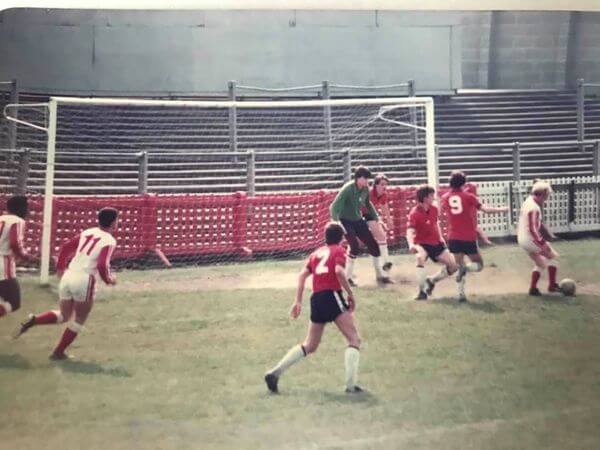
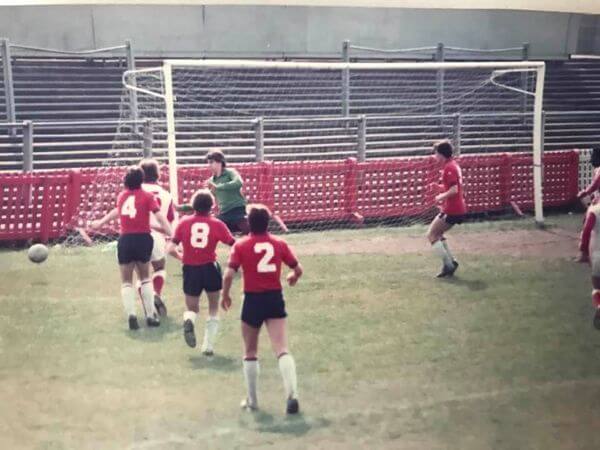
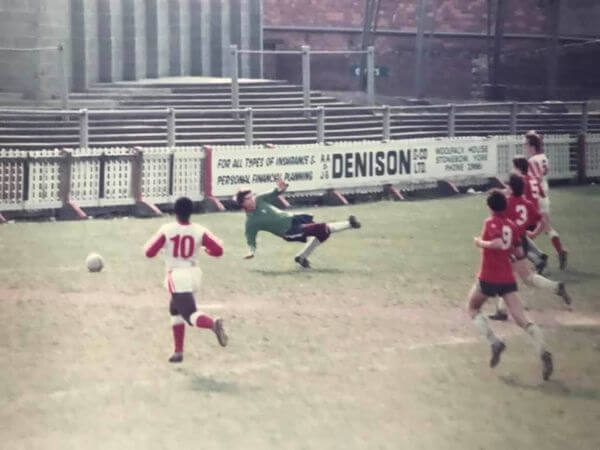
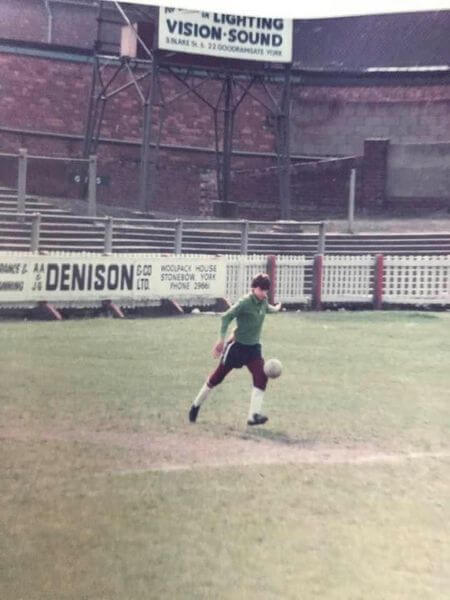
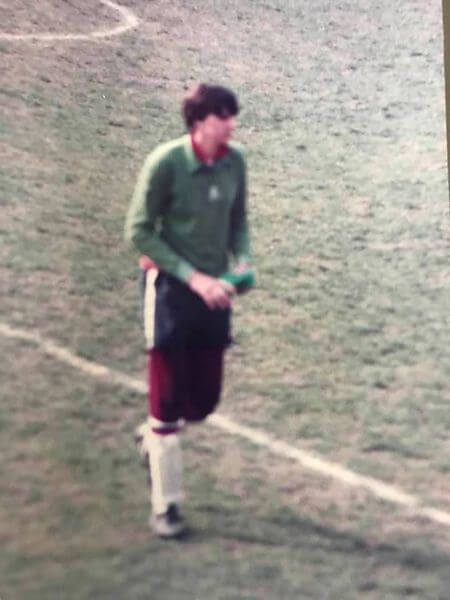
From footplate of bus and from platform of station,
Through Saturday lunchtime’s acclimatisation,
The scarved and bob-capped from days gone and present
Have strode through our streets to the lights of the crescent.
On weekdays and weekends our action replay;
Devoted, uncoated from August to May.
We chanted their names and we sang for the team;
We watched from the wings as they lived out our dream.
For this is the place where Wilkinson, Storey
And Bottom and Fenton took City to glory:
In ‘55 Blanchflower, Ramsey were gone
As we rolled over Spurs in the Cup, 3-1.
In ‘48, Patrick, v Rotherham hit five
As the red and white thousands in here came alive.
Those epic encounters when Liverpool came,
And the back from the brink in that Southampton game.
And that icy last minute with hearts in a knot,
As the ball took its place on the penalty spot.
When the Crescent grew hushed and the Arsenal did quake
And Houchen rolled in and made this old ground shake.
Let’s remember the men who anointed this turf:
From Forgan, MacMillan, through David McGurk.
The good on the deck and the great in the air -
See Boyer and Burrows and Parslow and Blair
The soldiers supreme that were glued to the ball:
Canham and Creswell and Bishop and Hall.
And the boys in the dug-outs behind all the thrills:
Worthington, Lockie, Dennis Smith, Gary Mills.
And this is the place where we’d curse or discuss:
The three in attack or the parking the bus.
The tip of a diamond, the man-to-man marking,
The roaring, the shouting, the growling, the barking
The chipping, the bending, the lobbing and curling;
The scarves and the flags and the banners unfurling.
The spins and the grins and the tricks and flicks
And the tap-ins, the clapping, the overhead kicks.
The chanting and ranting, the whinging and moaning;
The car journey home and the radio phone-in.
For here on this ground are the fakes and the feins,
And the race down the flanks and the rush in our veins
The tackles, the barges, the trips and the slides -
And the ghosts and the glides and the never off-sides.
This is the place where the mud and the sweat
Gave us just past the post or a bulge in the net.
And this is the place that thumps its own chest,
That looks to the future and kisses its crest.
And as day turns to dark and the floodlights grow dim
And the shutters are drawn and the shadows move in.
As the kit bags are packed and the boot room is cleared,
When the fans and the players have long disappeared.
As the lines on the overgrown grass start to fade
And the hard hats move in with the pick and the spade,
We’ll roll up our programmes and save souvenirs
And we’ll look to the future through eyes full of tears
And the songs from the stands will ring in our ears
As the whistle blows time on our eighty-eight years.
Chuitar remembered Bootham Crescent in Bye Bye Bootham to the tune of The Stone Roses "Bye Bye Badman".
No real chance to say goodbye, people attending the last game didn't know it was the last game and the last 2 games postponed.